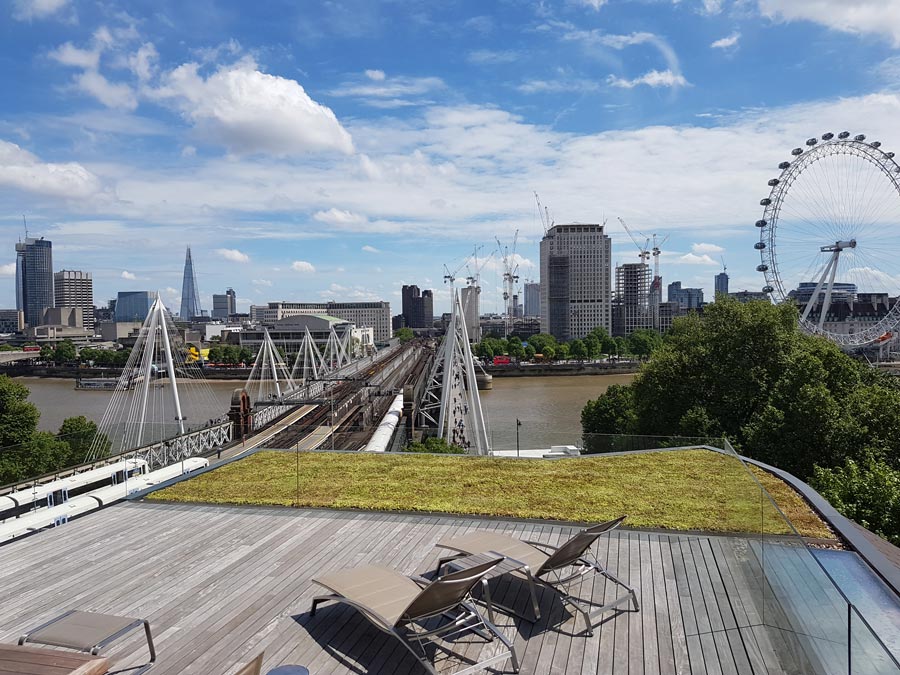Rainwater Attenuation
Green and Blue Roofs
More and more impermeable surfaces such as roads and buildings are constructed at the expense of permeable surfaces such as fields and meadows. The result of rain falling on hard surfaces is that it runs straight off through the drainage systems into rivers.
Therefore, in times of heavy or prolonged rainfall, existing drainage systems have to cope with large volumes of water which often, when built, were not designed to do so. This can result in them backing up and subsequent flooding especially during summer storm events.
The major flooding seen over recent years can be partly attributed to the increase in built up areas and reduction of vegetated areas. Therefore, developers are ‘strongly encouraged’ by planners to employ Sustainable Urban Drainage Systems (SuDS) on new developments.
SuDS are “A sequence of management practices and control structures designed to drain surface water in a ‘more sustainable’ fashion than some conventional techniques” (CIRIA 2000).
The Environment Agency can request that local authorities put conditions on planning permission such that the developer must restrict run off from the site to greenfield levels for a 100-year storm event.
PPG 25 (Development and Flood Risk) recommends that SuDS should be considered for new developments and encourage local authorities to include them in their development plans.


Green roofs as source control for SuDS:
- Water falling as rainfall onto a green roof is held within the pore spaces of the growing medium.
- Water is taken up and used by the plants.
- Some of the water held within the plant is lost back to the atmosphere by evapotranspiration.
- Rain droplets are often trapped within the vegetation and can then evaporate back into the atmosphere.
- Water can be held within the drainage system of the green roof build up.
- The drain water run-off rate is very much reduced due to the time it takes for the water to percolate through the green roof build up and out via the drainage outlets. This, therefore, releases any excess water over a longer time period enabling the terrestrial drainage systems to cope better.
The table below highlights the reduction in rainfall run-off, as the depth of substrate increases.
ROOF TYPE…………………………………RUN-OFF PERCENTAGE
- STANDARD 81%
- STANDARD + 50mm of Gravel 77%
- Green Roof + 50mm of Substrate 50%
- Green Roof + 100mm of Substrate 45%
- Green Roof + 150mm of Substrate 40%
Blue Roofs
A Blue Roof is designed to attenuate incident rainfall at roof level, and typically has a green roof as the surface finish. Utilising ‘geocells’ above the roofing system to provide a multidirectional free flowing path for water to reach the drainage points on the roof surface, these geocells provide a void that is designed to provide the attenuation capacity for the storm water.
Primarily suitable for zero falls flat roofs Blue Roofs are designed to allow controlled attenuation of rain fall during heavy and storm events as part of a Sustainable Urban Drainage Systems (SuDS) good practise policy, replicating the natural environment or improving the as built environment. A Blue Roof will treat and release the water at a managed and controlled rate directly into the sewers waterways and river systems
Blue Roof can be created at either roof or podium level above the waterproofing membrane in a warm roof application and above the water flow reducing layer (WFRL) in an inverted application, and should attenuate water for no more than a 24 hour period from the end of the maximum designed rainfall event. The discharge rate should be calculated to allow the roof to be half empty of attenuated water in a 12 hour period.
Currently there are no standards for Blue Roofs but in October 2019 CIRIA achieved the funding they required to begin work on proposal 3084: Guidance on blue roofs – specification and contractor selection. This project will run for 18 months to 2 years and in the meantime information on Blue Roofs can be obtained via the NFRC Technical Guidance Note for the construction and design of Blue Roofs. Roofs and podiums with controlled temporary water attenuation. A copy can be downloaded here.

